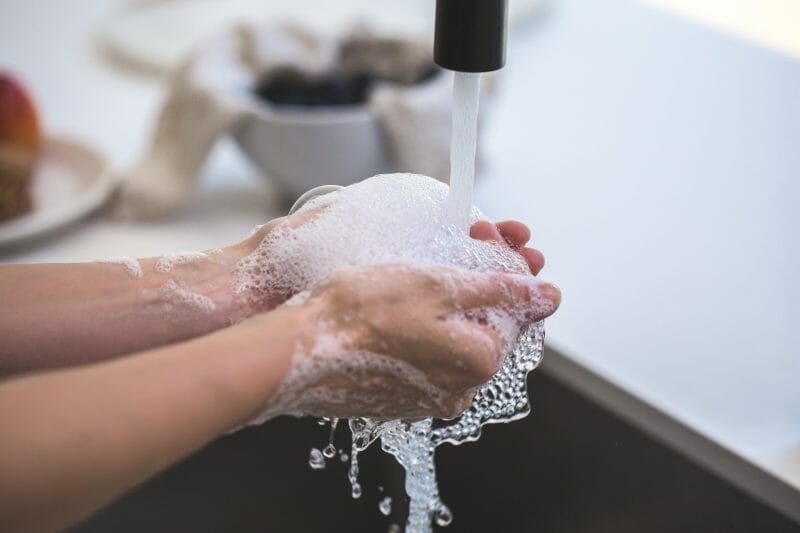Having issues with the regular shampoos you find at the drugstore or wanting to improve your carbon footprint? Find out how to make shampoo at home.

Should you make your own shampoo?
Making your own shampoo can have great benefits for your skin, scalp and wallet! The process is not very time consuming and the ingredients are mostly inexpensive and easy to fin. Many people struggle with finding the right shampoo, or want to make sure they know what they’re using. In those cases, making your own shampoo is a great asset!
While our recipe uses organic-only ingredients and is kind on your strands (also perfect if you’re going No Poo!), it doesn’t keep for long, so if you use shampoo sparingly you might have to take extra precautions or maybe make a smaller batch.
Need more reasons?
While some of the ingredients are a bit more pricey, they only require a small amount for use in the recipe. Besides, they all serve other purposes, like, skincare routine. It is also a great routine to save some money in the long run. If you’re afraid how your hair will react, try mixing it first with your regular shampoo, and keep adding more of it till you’re completely used to the shampoo you made yourself!
Don’t be afraid to fiddle around with the recipe! If your hair is already oily, try using less oils, or more if your hair is dry. You might even need to pamper your hair with coconut oil after washing, in case you need more moisturizing.
The great thing about doing your own hair care is that you can customize it to your needs and that you know exactly what goes into it.
Ingredients you will need:
- Full-fat coconut milk – for moisture and even texture
- Raw honey – for moisture and strength
- Apple cider vinegar – provides shine and helps clean your scalp
- Joboba oil – helps to protect and regenerate the hair
- Castor oil – adds shine and prevents split ends
- Essential oils (optional) – for a fragrance of your choice, such as lavender, peppermint, rosemary or tea tree
How to make your own shampoo (the steps)
1. Preparing the ingredients
Going into the recipe, you will also need:
- a bowl and a whisk to mix all the ingredients together
- a scale to measure the ingredients
- container to store the shampoo
2. Mixing the ingredients in 3 simple steps:
- First, you need to combine around 13.5 ounces of the coconut milk with two tablespoons of apple cider vinegar and a similar amount of raw honey;
- Then, add one teaspoon of both the oils and essential oils, and mix all the ingredients together until smooth. Be careful: if you have naturally oily hair, you might want to use less oil while preparing the product, or add extra apple cider vinegar.
- Lastly, pour into the container you had set aside with the help of a spatula slowly pour it. You might want to store it in the fridge to make it last longer.
3. Using the shampoo
Before using you might want to shake it well, as some of the ingredients might separate if left untouched for too long.
Then it’s time for a shower! Use it as a normal shampoo and massage a small amount on the scalp using your fingers. Leave it on for a few minutes before rising it off, as the oils are great for your scalp and the vinegar will leave your hair shiny and clean.
Although this won’t make the same soapy suds as regular shampoos, it will still clean and moisturize your hair. Don’t use too much though, or you’ll end up with leftover residue in your hair.
Extra tips
It might be best to make smaller batches at first if you are concerned about how this recipe will work out for you or if your skin is particularly finicky one way or the other, and perfect it via trial and error. Consider your kind of hair and adapt it to your needs: oily hair demands less natural oils, whether dry and frizzy hair could definetely use more of those!
This recipe was developed by Pronounce Skincare which also formulates several recipes for skincare and hair care using natural and organic products.
Final words
So, did you learn how to make shampoo at home? Making your own shampoo and knowing what goes into it has several benefits for the health of both your hair and your scalp, and is great for the environment as well. Share with us some other tips and tricks regarding natural shampoo and hair care, and let us know if our article inspired you to try out this recipe!



Can I use a different type of oil for regeneration? Thanks for sharing by the way! :)
Definitely, yes! :)
I don’t think this could clean the hair though
Thanks for the feedback, Tina. What do you think would help? Worked great for me:-)